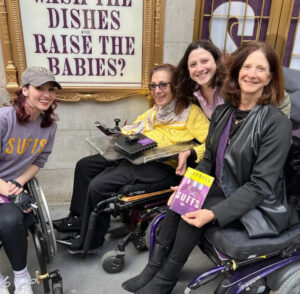Author Sheri Denkensohn-Trott
Accessibility and inclusion have improved greatly on the screen and stage. I’m thrilled to hear of the latest TV show starring individuals with disabilities, movies with parts that are not disability specific or star individuals with disabilities telling their story, and stage productions with an actor who is disabled playing a role. That’s the way it should be. Thirty-plus years post the Americans with Disabilities Act (ADA), it’s about time that disability and the arts seamlessly co-exist.
I recently saw a play and was a wheelchair user in the audience. I traveled all the way from Arlington, Virginia to New York City with another friend who uses a wheelchair to see the Broadway production of SUFFS.  We planned this adventure months in advance because of our interest in the women’s suffragist movement and the added benefit that actress Jenna Bainbridge, who uses a wheelchair, was in the show. The production was fabulous, and we met Jenna afterwards. Icing on the cake. But the problem in between was the seating. Wheelchair seating is very limited, it is on the edges of the theater with limited view, and aisles are incredibly narrow. To move back for those in my aisle to get out meant that those behind me could not. To move forward so those behind me could get out, meant that those in my aisle could not. I thought I did everything right when I purchased tickets, but at the last minute we didn’t know if we could all see the show. (Luckily with lots of scrambling it all worked out, and don’t let this dissuade you from going to the show).
We planned this adventure months in advance because of our interest in the women’s suffragist movement and the added benefit that actress Jenna Bainbridge, who uses a wheelchair, was in the show. The production was fabulous, and we met Jenna afterwards. Icing on the cake. But the problem in between was the seating. Wheelchair seating is very limited, it is on the edges of the theater with limited view, and aisles are incredibly narrow. To move back for those in my aisle to get out meant that those behind me could not. To move forward so those behind me could get out, meant that those in my aisle could not. I thought I did everything right when I purchased tickets, but at the last minute we didn’t know if we could all see the show. (Luckily with lots of scrambling it all worked out, and don’t let this dissuade you from going to the show).
Broadway theaters are old. In most cases, accessibility is achieved by removing theater chairs from the floor. It creates a narrow spot not well designed for a large power wheelchair. And in this theater, there were only four or five wheelchair spots. This becomes more complicated when you attend with a companion or a group.
I must admit, I have not been to theaters all over the country. In Washington DC, I have attended many shows at the Kennedy Center. They have wheelchair seating throughout their different theaters in rows with chairs that can be easily moved so that a wheelchair can fit. A companion can sit next to the wheelchair in a regular seat. Not every theater in Washington DC is like this. One theater removes a chair, but the wheelchair space is on an incline. Given that I have limited body support, it took every muscle that I had to hold myself up during the production. Result, not enjoyable and I avoid that theater.
I understand the ADA and know that if a major renovation does not take place the requirement to fully redesign seating may not necessarily be required. But the letter and spirit of the law are two different things. Wheelchair users want to enjoy the arts. As the population ages, this number will exponentially increase. If theaters don’t change, they will eventually lose out on attendees and revenue. This is an industry that is still recovering from COVID and is not an inexpensive treat.
 I want to see productions of all types. I have an expectation that I can obtain a seat that is accessible, comfortable, and purchased through a seamless process. After this latest experience, I’m realizing that going to the theater is now another research project. First, who is the right person to contact before I purchase my tickets? How do I determine that my seat will give me a good view and a companion will be next to me? Will there be enough room where I sit? Can individuals easily navigate around my power chair? And will all go smoothly after I’ve double checked every aspect of the visit and I arrive at the show?
I want to see productions of all types. I have an expectation that I can obtain a seat that is accessible, comfortable, and purchased through a seamless process. After this latest experience, I’m realizing that going to the theater is now another research project. First, who is the right person to contact before I purchase my tickets? How do I determine that my seat will give me a good view and a companion will be next to me? Will there be enough room where I sit? Can individuals easily navigate around my power chair? And will all go smoothly after I’ve double checked every aspect of the visit and I arrive at the show?
I have raised many questions. They are all reasonable. It may take years, but it’s time to recognize that change is overdue. If you play any role in the operation and/or design of a theater, please consider the experience of the audience, specifically those with disabilities. Evaluate your seating process from start to finish and involve individuals who are end-users in the process. I speak for those with physical disabilities, but there are multiple disabilities to consider. We want and deserve to attend shows without hours of research and lingering worry. Seeing a performance should be meaningful and enjoyable for all.

